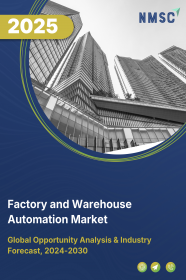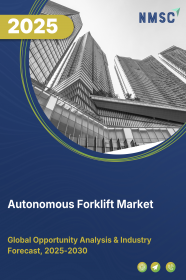
Industrial Automation Market by Component, (Hardware, Software, Services), by Automation Type, (Fixed (hard) Automation, Programmable Automation, Flexible (soft) Automation, Integrated Automation), by Mode Of Automation, (Semi‑automation (human + Machine), Fully‑automated (unsupervised Operation)), by Deployment Model, (On‑premises, Cloud‑based / Saas), by Industry (end‑user), (Discrete Industries, Process Industries) - Global Opportunity Analysis and Industry Forecast 2024-2030
Market Definition
The Industrial Automation Market size was valued at USD 191.28 billion in 2023 and is predicted to reach USD 363.31 billion by 2030 with a CAGR of 9.60% from 2024-2030.
Industrial automation refers to the use of advanced technologies, systems, and machinery to automate and control industrial processes, tasks, and operations. It involves the integration of various components such as sensors, actuators, controllers, and software applications to monitor and manage industrial processes with minimal human intervention. Industrial automation aims to improve efficiency, productivity, and safety in manufacturing, assembly, and other industrial operations by reducing manual labor, optimizing resource utilization, enhancing product quality, and enabling faster and more accurate decision-making. It encompasses a wide range of automation technologies, including robotics, programmable logic controllers (PLCs), human-machine interfaces (HMIs), machine vision systems, and advanced data analytics.
Market Dynamics and Trends
The demand for the industrial automation market is increasing due to the growing demand for automation across various sectors, including manufacturing, automotive, and logistics, which are seeking ways to optimize their operations and improve productivity. Industrial automation provides solutions such as robotics, artificial intelligence, and advanced control systems that streamline processes, reduce errors, and enhance overall efficiency.
Moreover, rapid advancements in technology, such as the Internet of Things (IoT), machine learning, and big data analytics, have revolutionized industrial automation. These technologies enable real-time data monitoring, predictive maintenance, and autonomous decision-making, empowering industries to achieve higher levels of automation and operational excellence.
Additionally, the growing need for autonomation in the food and beverage industry is driving increased demand for industrial robots. Manufacturers are increasingly adopting automation solutions, leveraging industrial robots to enhance production processes, efficiency, and product quality and safety.
This trend is particularly pronounced in the food and beverage sector, where companies are seeking innovative ways to streamline operations. In April 2023, Doosan Robotics introduced a line of cobots certified by the NSF specifically for the food and beverage industry. The E-series robots feature lightweight and slim designs, making them suitable for installation in various workspaces within the food and beverage sector.
However, implementing industrial automation systems often requires substantial upfront investment in equipment, software, and infrastructure. Therefore, it can be a barrier for some companies, especially small and medium-sized enterprises (SMEs) with limited financial resources, which may restrain the growth of the market.
On the other hand, the integration of artificial intelligence (AI) and machine learning (ML) in industrial robots is expected to unlock significant growth opportunities for the industrial automation market in the future. As industries increasingly prioritize automation and smart manufacturing solutions, the integration of AI and ML in industrial robots will play a pivotal role in driving innovation, competitiveness, and growth in the industrial automation market.
Market Segmentation and Scope of Study
The global industrial automation market is segmented on the basis of component, type, end user industry, and region. Based on component, the market is classified into hardware, software, and services. Based on the type, the market is segmented into, programmable logic controller (PLC), supervisory control and data acquisition (SCADA), distributed control system (DCS), human machine interface (HMI), remote terminal unit (RTU), industrial robots, machine vision, and others. On the basis of the end-user industry the market is categorized into, automotive, chemicals and petrochemicals, pharmaceuticals, food & beverages, oil & gas, metals & mining, electronics & semiconductor, and others. Geographical breakdown and analysis of each of the aforesaid classifications include regions comprising of North America, Europe, Asia-Pacific, and RoW.
Geographical Analysis
Asia-Pacific dominates the global industrial automation market trend and is potently expected to remain dominant in the market throughout the forecast period. This is attributed to the growing automotive industry in countries such as China and India, that are experiencing a rise in automotive manufacturing and demand, there is a greater need for efficient and automated production processes.
According to the International Trade Administration, China continues to be the world’s largest vehicle market by both annual sales and manufacturing output, with domestic production expected to reach 35 million vehicles by 2025. As a result, the industrial automation market in Asia Pacific benefits from the automotive industry's expansion, supporting its growth and advancing manufacturing capabilities across the region.
Moreover, the growing semiconductor industry in the Asia Pacific including leading countries in semiconductor manufacturing such as China, South Korea, Taiwan, and Japan is further accelerating the growth of the industrial automation market in the region.
According to the Semiconductor Industry Association, by far, the largest country market in the Asia Pacific region is China, which accounted for 56 percent of the Asia Pacific market and 35 percent of the total global market. On the other hand, North America shows substantial growth in the global industrial automation market owing to the integration of industrial automation in Water and Wastewater (WWW) to control water treatment processes and monitor water quality, as water resources become scarcer and the demand for clean water continues to grow.
For instance, in October 2022, Schneider Electric partnered with Delco Automation, a premiere integrator of process automation and control systems in North America. The Certified Alliance Partner accreditation authorizes Delco Automation to bring Schneider Electric solutions in Water and Wastewater (WWW), training, and expertise through process control, supervisory control, SCADA, DCS, PLC, information systems, instrumentation, measurement, telecommunication systems, and control centers.
Furthermore, the presence of key market players such as Honeywell International Inc., Rockwell Automation, and General Electric that are adopting various strategies including business expansion is further propelling the growth of the market.
For instance, in March 2023, Honeywell announced its efforts to bridge the automation interoperability gap as the company prepares to invest nearly USD 22 billion in warehouse technology. Honeywell aims to provide solutions that enable seamless communication and collaboration between various automation platforms, leading to enhanced operational efficiency and productivity. The substantial investment reflects Honeywell's commitment to advancing warehouse technology and facilitating smoother automation processes in the industry.
Competitive Landscape
Various market players operating in the industrial automation market include Siemens AG, Honeywell International Inc, Schneider Electric SE, ABB Ltd, Emerson Electric Co, Rockwell Automation Inc, Mitsubishi Electric Corporation, FANUC Corporation, Keyence Corporation, Omron Corporation, Yokogawa Electric Corporation, KUKA AG, Bosch Rexroth, Phoenix Contact GmbH & Co. KG, Delta Electronics, Inc. These market players are adopting various strategies such as product launches and collaboration to maintain their dominance in the global Industrial Automation market.
For instance, in January 2025, Siemens AGUnveiled the Siemens Industrial Copilot for Operations, bringing Industrial AI directly to the shop floor, integrated within the Industrial Edge ecosystem.
Also, in April 2025, ABB LtdAnnounced plans to spin off its Robotics division as a standalone, publicly listed company—expected to be listed in Q2 2026, distributing shares to ABB investors via dividend-in-kind.
Furthermore, in October 2024, Honeywell International Inc.Announced the plan to spin off its Advanced Materials business (later named Solstice Advanced Materials), targeted for completion by the end of 2025 or early 2026.
Key Benefits
-
The report provides quantitative analysis and estimations of the industrial automation market from 2024 to 2030, which assists in identifying the prevailing market opportunities.
-
The study comprises a deep-dive analysis of the industrial automation market including the current and future trends to depict prevalent investment pockets in the market.
-
Information related to key drivers, restraints, and opportunities and their impact on the industrial automation market is provided in the report.
-
Competitive analysis of the players, along with their market share is provided in the report.
-
SWOT analysis and Porter’s Five Forces model is elaborated in the study.
-
Value chain analysis in the market study provides a clear picture of the roles of stakeholders.
Key Market Segments
By Component
-
Hardware
-
Controllers
-
Programmable Logic Controllers (PLC)
-
Distributed Control Systems (DCS)
-
Remote Terminal Units (RTU)
-
-
Drives & Motors
-
AC Drives & Motors
-
DC Drives & Motors
-
-
Robotics
-
Industrial Robots
-
-
Sensing & Vision
-
Sensors
-
Machine Vision Systems
-
Safety Light Curtains & Laser Markers
-
-
Field Instruments & Valves
-
Process Analyzers
-
Control Valves
-
-
Operator Interfaces
-
Human–Machine Interfaces (HMI)
-
Industrial PCs
-
-
-
Software
-
Supervisory & Control
-
SCADA
-
Supervisory Control & Data Acquisition
-
-
Execution & Management
-
Manufacturing Execution Systems (MES)
-
Plant Asset Management (PAM)
-
-
Advanced & Analytics
-
Advanced Process Control (APC) & Model‑Based Control
-
Digital Twins & IIoT Platforms
-
Functional Safety & Emissions Control
-
-
IT/OT Integration
-
Enterprise‐Level Controls (PAC)
-
Cybersecurity for Industrial Control Systems
-
-
-
Services
-
System Integration & Engineering
-
Consulting & Digital‑Transformation Road‑maps
-
Installation, Commissioning & Training
-
Maintenance, Upgrades & After‑Sales Support
-
By Automation Type
-
Fixed (Hard) Automation
-
Programmable Automation
-
Flexible (Soft) Automation
-
Integrated Automation
By Mode of Automation
-
Semi‑Automation (human + machine)
-
Fully‑Automated (unsupervised operation)
By Deployment Model
-
On‑Premises
-
Cloud‑Based / SaaS
By Industry (End‑User)
-
Discrete Industries
-
Automotive & Transportation
-
Electronics & Semiconductors
-
Packaging & Consumer Goods
-
Machinery & Equipment Manufacturing
-
-
Process Industries
-
Oil & Gas
-
Chemicals & Petrochemicals
-
Pharmaceuticals & Biotechnology
-
Food & Beverage
-
Pulp & Paper
-
Mining & Metals
-
Energy & Utilities
-
By Application
-
Process Monitoring & Control
-
Assembly & Line Automation
-
Material Handling & AGVs
-
Quality Control & Inspection
-
Supply‑Chain & Warehouse Automation
-
Asset Performance & Predictive Maintenance
-
Safety & Emission Monitoring
By Enterprise Size
-
Large Enterprises
-
Small & Medium‑sized Enterprises (SMEs)
By Region
-
North America
-
The U.S.
-
Canada
-
Mexico
-
-
Europe
-
The U.K.
-
Germany
-
France
-
Italy
-
Spain
-
Denmark
-
Netherlands
-
Finland
-
Sweden
-
Norway
-
Russia
-
Rest of Europe
-
-
Asia-Pacific
-
China
-
Japan
-
India
-
South Korea
-
Australia
-
Indonesia
-
Singapore
-
Taiwan
-
Thailand
-
Rest of Asia-Pacific
-
-
Rest of the World (RoW)
-
Latin America
-
Middle East
-
Africa
-
Key Players
-
Siemens AG
-
Honeywell International Inc.
-
Schneider Electric SE
-
ABB Ltd
-
Emerson Electric Co.
-
Rockwell Automation Inc.
-
Mitsubishi Electric Corporation
-
FANUC Corporation
-
Keyence Corporation
-
Omron Corporation
-
Yokogawa Electric Corporation
-
KUKA AG
-
Bosch Rexroth
-
Phoenix Contact GmbH & Co. KG
-
Delta Electronics, Inc.
Report Scope and Segmentation
|
Parameters |
Details |
|
Market Size in 2023 |
USD 191.28 Billion |
|
Revenue Forecast in 2030 |
USD 363.31 Billion |
|
Growth Rate |
CAGR of 9.60% from 2024 to 2030 |
|
Analysis Period |
2023–2030 |
|
Base Year Considered |
2023 |
|
Forecast Period |
2024–2030 |
|
Market Size Estimation |
Billion (USD) |
|
Growth Factors |
|
|
Countries Covered |
28 |
|
Companies Profiled |
15 |
|
Market Share |
Available for 10 companies |
|
Customization Scope |
Free customization (equivalent up to 80 working hours of analysts) after purchase. Addition or alteration to country, regional, and segment scope. |
|
Pricing and Purchase Options |
Avail customized purchase options to meet your exact research needs. |

















 Speak to Our Analyst
Speak to Our Analyst
























